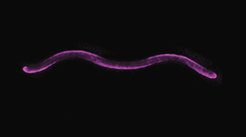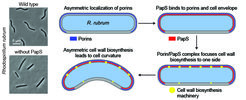What brings bacteria into shape?
A protein determines the shape of bacteria and thus their capabilities
Bacteria come in a wide variety of shapes, which are important for their fitness in their respective ecological niches. However, despite intensive research, the factors that determine the shape of bacterial cells remain, in many cases, unknown. A team of researchers led by Prof. Martin Thanbichler has now discovered the mechanism that determines the spiral shape of Rhodospirillum, shedding new light on the link between cell shape and fitness.

Imagine a bacterium. What does it look like? Round or rod-shaped? In fact, bacteria come in a surprising variety of shapes. In addition to rod-shaped representatives such as the widely known model bacterium E. coli, there are numerous curved and even spiral-shaped bacteria. Curvature is crucial to the ability of bacteria to colonize surfaces and move in viscous environments - and thus also to cause disease, as is the case for Vibrio cholerae or Helicobacter pylori. Researchers worldwide are working to understand the molecular details of bacterial cell curvature, with the hope of someday being able to influence it and thus potentially combat pathogens.
The bacterium Rhodospirillum rubrum: Spiral distribution of PapS and porins in the cell wall
Now an international research team led by Max Planck Fellow Martin Thanbichler, Professor at the University of Marburg, Germany, has provided new insights into the shape of the photosynthetic bacterium Rhodospirillum rubrum. This species is widespread in the environment and has biotechnological potential because it can utilize carbon monoxide, fix nitrogen and produce both hydrogen and building blocks for bioplastics.
The researchers were surprised to find that in Rhodospirillum two so-called porins – channel-like proteins that so-far were only known to be only responsible for the exchange of nutrients across the outer membrane of bacteria – are arranged helically in the outer curvature of the cell. These structures are closely connected to the cell wall by another protein, the lipoprotein PapS. Surprisingly, when PapS was missing or when the researchers prevented it from binding to the porins, the cells became completely straight.

But why is PapS essential for cell curvature? "The porins seem to have evolved to perform a second function apart from exchanging nutrients," explains Prof. Martin Thanbichler. "Together with PapS, they control the movement of a molecular machine that travels in circles around the cell body. This machine incorporates new material into the existing cell wall and thus leads to cell elongation. In rod-shaped bacteria such as E. coli, this machine moves uniformly in all areas of the cell, resulting in a straight shape. In R. rubrum, by contrast, the helical Porin-PapS structure forms a kind of molecular cage. Due to its dense packing, it surrounds the machinery that is normally responsible for the longitudinal cell growth and partially fixates it in the outer curve of the cell. This results in a local increase in cell elongation around the Porin-PapS structure, which ultimately bends the cell body into a spiral shape.”
The study, in which the Marburg team worked together with researchers from Kiel, Freiburg, England and Australia, has uncovered a novel mechanism of shape determination in bacteria that is based on the direct influence of outer membrane proteins on the spatial control of cell growth. The findings are likely to apply to all curved relatives of Rhodospirillum, and it will be exciting to see whether this mechanism is also used by other bacterial groups with more complex cell shapes.
"We now have the opportunity to modify the cell shape of R. rubrum. This will give us the opportunity to study the selective advantage of the helical cell shape for bacteria in their habitat," says Dr Sebastian Pöhl, first author of the study. This could provide important insights into how cell shape affects the colonization of ecological niches, the establishment of symbiotic interactions with plants, or the cause of disease.














